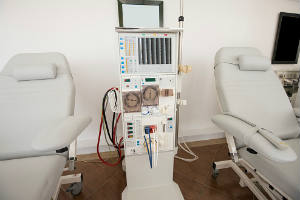Why do Japanese Hemodialysis Patients Live Longer than their American & European Counterparts?
 It has been observed that Japanese hemodialysis (HD) patients live longer than HD patients in North America and Europe. In an editorial in Artificial Organs, Dr. Matsuda, past president of the Society of Artificial Organs, and colleagues Rachel Fissell and Stephen Ash from the United States and Bernd Stegmayr from Sweden explore the different factors that may contribute to superior survival of Japanese hemodialysis patients. It is their hope that by identifying key Japanese practice patterns, they could be optimized to improve the survival of HD patients in other countries.
It has been observed that Japanese hemodialysis (HD) patients live longer than HD patients in North America and Europe. In an editorial in Artificial Organs, Dr. Matsuda, past president of the Society of Artificial Organs, and colleagues Rachel Fissell and Stephen Ash from the United States and Bernd Stegmayr from Sweden explore the different factors that may contribute to superior survival of Japanese hemodialysis patients. It is their hope that by identifying key Japanese practice patterns, they could be optimized to improve the survival of HD patients in other countries.
Demographically, in Japan, there are more men on dialysis than women (59% vs. 41%). Japanese hemodialysis patients smoke more than their counterparts in other countries. They are better educated, more are married, and employed, and they have fewer mental health issues.
Japanese Practice Patterns:
- Vascular Access: In Japan there is higher AV fistula use and lower catheter use. Furthermore, their culture may influence Japanese patients to better adhere to a treatment plan resulting in swifter, more timely surgery, and the use of more lower arm AV accesses than in the U.S. or Europe.
- Volume Management: In Japan, treatment times are longer. This results in less rapid ultrafiltration rates and lower pump speeds that allow more bubbles to evaporate which could reduce the burden of micro air emboli (MAE) within the extracorporeal circuit. MAE may cause myocardial dysfunction and damage to other organs (heart, lungs, brain). The longer, slower and more complete volume removal in Japan not only minimizes MAE, but supports greater clearance of middle and larger molecules, and small solutes such as urea.
- Supine Position: Japanese patients are dialyzed while lying down. This supine position alleviates hypovolemia which occurs during ultrafiltration, and decreases vascular resistance in the leg, recruiting blood volume into the central circulation.
- In-Center Dialysis: Although renal transplant and home dialysis are generally preferred in other countries, such is not the case in Japan where there are few transplants.
- Medications/Inflammation: In Japan, there is less intensive anemia management. They use fewer antibiotics to combat inflammations caused by catheters. This reduces development of antibiotic resistance and lessens the harmful side effects of antibiotic use. Lab data of Japanese patients show fewer inflammation markers which also suggests lower blood viscosity, a factor that also could be associated with better survival.
- Low Fat (Triglyceride) Diet: Japanese patients rarely eat during dialysis. The Japanese culture’s limited-fat diet minimizes the blood viscosity levels of patients who do eat during dialysis, as compared to other countries.
Conclusions:
Differences in comorbidities between Japanese HD patients and HD patients from other countries does not fully explain the superior survival in Japanese HD patients. Notable differences between Japanese practice modalities and those in other countries include prevalence of AV fistulas, fewer catheters, longer treatment times, slower ultrafiltration rates, meticulous attention to minimizing air emboli during treatment, less intensive anemia management, and less use of antibiotics. Cultural differences that also could contribute to longer survival include Japanese adherence to a recommended diet, patients remain for the full treatment and do not eat high fat foods prior to and during treatment.



